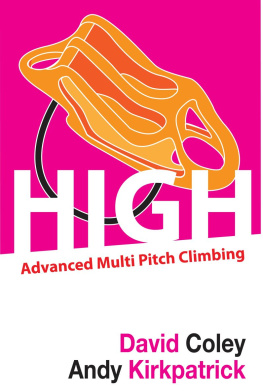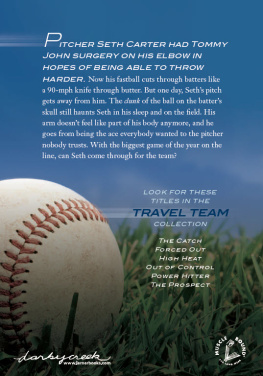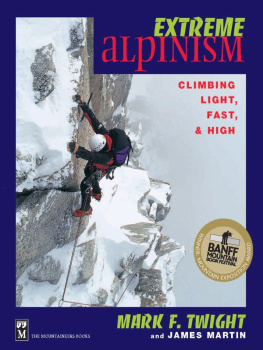Andrew Kirkpatrick - High: Advanced Multi Pitch Climbing
Here you can read online Andrew Kirkpatrick - High: Advanced Multi Pitch Climbing full text of the book (entire story) in english for free. Download pdf and epub, get meaning, cover and reviews about this ebook. year: 2013, genre: Science. Description of the work, (preface) as well as reviews are available. Best literature library LitArk.com created for fans of good reading and offers a wide selection of genres:
Romance novel
Science fiction
Adventure
Detective
Science
History
Home and family
Prose
Art
Politics
Computer
Non-fiction
Religion
Business
Children
Humor
Choose a favorite category and find really read worthwhile books. Enjoy immersion in the world of imagination, feel the emotions of the characters or learn something new for yourself, make an fascinating discovery.
- Book:High: Advanced Multi Pitch Climbing
- Author:
- Genre:
- Year:2013
- Rating:4 / 5
- Favourites:Add to favourites
- Your mark:
- 80
- 1
- 2
- 3
- 4
- 5
High: Advanced Multi Pitch Climbing: summary, description and annotation
We offer to read an annotation, description, summary or preface (depends on what the author of the book "High: Advanced Multi Pitch Climbing" wrote himself). If you haven't found the necessary information about the book — write in the comments, we will try to find it.
High: Advanced Multi Pitch Climbing — read online for free the complete book (whole text) full work
Below is the text of the book, divided by pages. System saving the place of the last page read, allows you to conveniently read the book "High: Advanced Multi Pitch Climbing" online for free, without having to search again every time where you left off. Put a bookmark, and you can go to the page where you finished reading at any time.
Font size:
Interval:
Bookmark:
HIGH
Advanced Multi Pitch Climbing
Coley/Kirkpatrick
CONTENTS

WARNING
CLIMBING IS DANGEROUS
This manual is designed to give climbers the skills necessary to stay safe, but rock climbing and mountaineering is inherently dangerous, and so this manual is written for experienced rock climbers and mountaineers only. No one should undertake climbing without the proper training or equipment, and must take personal responsibility for learning the proper techniques and employing good judgment. I strongly recommend that every climber seek instruction by a qualified professional if they are unsure of any aspect of this manual.
By using the information contained within this manual you acknowledge that the information therein may be out of date or inaccurate and you agree that the author cannot be held liable for any damage that may be caused by use of this manual.
NOTES
GENDER & NOMENCLATURE
In the text the leader is almost always female, as in she, and the second(s) male, as in he.
A mix of American and British terminology and spelling have been used, as in square rather than reef knot, webbing rather than tape, colour rather than color. To encourage an international flavour, and relieve the monotony, rap, rappel, ab and abseil are all used and have the same meaning. Likewise, kit, gear and equipment all mean the same thing.
Although not technically correct, Spectra is identified with cord and Dyneema with webbing as this has become the common usage amongst climbers.
The term runner is used in the British sense as ANY piece of protection clipped to the rope but not part of the belay, rather than in the North American sense of a 60 or 120cm sling.
The word faff comes up a lot. For those that dont use the term, when applied to climbing, to faff (or faffing) means spending too much time sorting out ropes and equipment, rebuilding belays, etc. and generally wasting time.
ACKNOWLEDGEMENTS
Thanks to Duncan Kenny for his illustrations, even though we couldnt include them for technical reasons. Thanks to Steve Price and Pete Callaghan for sorting out the English as much as possible. Jim Titt for various words of advice, providing test data and explaining how things actually work and when some things might not. The Quay Climbing Centre, Exeter, for allowing their wall to be used for photography. Helen, Scartlett, Theo, James Tisshan, Leigh Arscott, Mark Garndener, Tom Eagle, Anne-Marie Dibner, Matthew Bano, Daniel Murphy, Charlotte Lloyd-Wrigley and various members of the South Devon Mountaineering Club and the 2 Degrees Climbing Club for helping out and agreeing to be models in photos. To Mummut, Lyon Equipment, e-climb, Climbing Technology, Edelrid and Petzl for providing equipment. And finally to anyone else we have forgotten
UNIT CONVERSION
The following data may help you convert the units discussed in the text.
1 km = 0.62 miles
1 metre = 3 ft 4 inch
1cm = 0.39 inch
1kg = 2.2 lbs
1litre = 1.7 pt
FEEDBACK AND UPDATES
If you have any feedback or questions regarding this book, perhaps were more clarity is needed (like a diagram), or just a spelling mistake, then please contact David ( )
Get in touch with Andy ( ) if you have any titles youd like to see, and you can follow Andy on twitter at @psychovertical, where he will note any updates on this or his other books.
Andys website at www.andy-kirkpatrick.com also has a ton of articles on technique, skills and assorted climbing obsessiveness!
COPYRIGHT
Copyright David Coley & Andy Kirkpatrick
All rights reserved. No part of this book may be reproduced or transmitted in any form or by any means, electronic or mechanical, including photocopying, recording, or any information storage and retrieval system, without prior written permission of the Author. Your support of authors rights is appreciated.
INTRO
Perhaps that tree climbing gene of our ape ancestors is stronger in climbers than in most people, Most of us climb simply because we feel happiest when were high. We begin scaling trees and hanging from playground climbing frames before moving onto climbing walls and outcrops, building up our strength and skill with every metre, trying routes that will test our nerve - eyes always on something steeper, harder, longer. Reaching the top of a rock route is always thrilling; stepping off the ground, clinging onto the rock, inching up, feeling that sense of peace when you scramble back onto the safe harbour of flatness. Some pitches are so good you never want them to end, and so that ape gene makes us seek out longer climbs; two pitches, ten pitches, thirty or even fifty. The higher we get the better we feel. Perhaps we do this out of some primitive urge to stay out of the clutches of predators, and for some of us the routes we climb, which once were measured in tens of metres and climbed in minutes, become climbs that are Empire State high, their passage spanning days.
It is often said that all climbers climb at roughly the same speed, it is the time they spend not climbing that differentiates them. Some of this time is spent trying to work out the moves, but much is also spent sorting out belays, re-racking gear at each stance and generally messing about with ropes. This book wont help you to move your limbs faster, but it will help you to spend less time not moving.
This book attempts to encourage climbers to try multi-pitch climbs wherever they find themin the mountains, on sea cliffs or deep within river gorgesand to climb them safely and efficiently. We have tried to fill the gap between books for beginners and books for those involved in professional guiding.
Much of the knowledge and equipment needed to climb longer routes is the same as that used for single pitch routes, and it is possible to climb such routes with no additional skills if you use a bit of forethought. However, you will most probably climb a lot more slowly, and also a little bit more hazardously. Without prior experience youre going to learn the hard way and a leader fall directly onto a belay which rips out almost all the pieces is not a good - or healthy - way to learn. This will restrict you to shorter or easier routes than you are capable off, and if something goes wrong you might be in trouble.
Apart from the usual hazards of single pitch climbing and being further from the ground, multi-pitch routes come with additional dangers. These are minor on smaller, 2 to 6 pitch routes but generally increase with the size of the cliff. More cliff above you means more potential for loose rockwhich can be dislodged by wind, melting snow, rain, goats or other climbers. Climbers can also drop kit (I (DC) nearly got taken out by a nut key dropped from high on El Cap when I was eating lunch at the base.) You may have to deal with tides and waves on sea cliffs. Getting to and from the cliff might mean crossing areas exposed to additional stone fall, or be on loose or grassy slopes above big drops. There may be the need to navigate complex terrain on the way in or the way out, and long multi-pitch raps are the norm on bigger routes. However, the greatest hazards are probably time and darkness. If you are new to something it will become harder in the dark, even with a headtorch, and harder normally means slower.
This book sets out to describe, not prescribe. There are many ways of doing most of the things discussed. Often a series of alternatives are given: single, double or twin ropes; belaying directly or indirectly; abseiling one at a time, or simultaneously; rescuing a second in half a dozen ways. The idea is to give you the tools for you to make your own decisions. We all have our preferences (including us), and sometimes these have arisen after years spent trying different techniques, but sometimes they simply represent the first way we were taught how to do something. This book tries to show you several ways of doing most things, but there will still be many alternatives not covered. Just because a method given here is different to yours doesnt mean either is wrong. Climbers use different approaches all over the world. Often these reflect the cliffs and history of their location. It is well worth studying these alternatives whenever you can, assessing whether you feel they are safe, then testing them in a safe environment and seeing if they work for you.
Next pageFont size:
Interval:
Bookmark:
Similar books «High: Advanced Multi Pitch Climbing»
Look at similar books to High: Advanced Multi Pitch Climbing. We have selected literature similar in name and meaning in the hope of providing readers with more options to find new, interesting, not yet read works.
Discussion, reviews of the book High: Advanced Multi Pitch Climbing and just readers' own opinions. Leave your comments, write what you think about the work, its meaning or the main characters. Specify what exactly you liked and what you didn't like, and why you think so.









